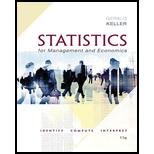
a:
Regression equation.
a:
Explanation of Solution
The general regression equation can be written as follows:
The term
Table 1 shows the processing of data as follows:
Table 1
| Sl | |||||
| 1 | -5 | 15 | 25 | 225 | -75 |
| 2 | -2 | 9 | 4 | 81 | -18 |
| 3 | 0 | 7 | 0 | 49 | 0 |
| 4 | 3 | 6 | 9 | 36 | 18 |
| 5 | 4 | 4 | 16 | 16 | 16 |
| 6 | 7 | 1 | 49 | 1 | 7 |
| Total | 7 | 42 | 103 | 408 | -52 |
Standard deviation
Standard deviation is -202.2.
The variance of x
The variance of x is 18.97.
The value of coefficient ( b1) can be calculated as follows:
The value of b1 is -1.065.
The average value
The average value of x is 1.167.
The average value
The average value of x is 7.
Intercept b0 can be calculated as follows:
The intercept value is 8.253.
Thus, the regression equation is given below:
b:
The predicted value of y.
b:
Explanation of Solution
The estimated value of y
Table 2 shows the predicted value of x that is obtained using the regression equation with different levels of x values as follows:
Table 2
| Sl | ||
| 1 | -5 | 13.58 |
| 2 | -2 | 10.38 |
| 3 | 0 | 8.253 |
| 4 | 3 | 5.058 |
| 5 | 4 | 3.993 |
| 6 | 7 | 0.758 |
c:
Calculate the residual.
c:
Explanation of Solution
The value of residual
Table 3 shows the residual value that is obtained using Equation (1) as follows:
Table 3
| Sl | |||
| 1 | -5 | 13.58 | 1.42 |
| 2 | -2 | 10.38 | -1.38 |
| 3 | 0 | 8.253 | -1.253 |
| 4 | 3 | 5.058 | 0.942 |
| 5 | 4 | 3.993 | 0.007 |
| 6 | 7 | 0.758 | 0.202 |
d:
Calculate the standardized residual.
d:
Explanation of Solution
The variance of y
The variance of y is 22.8.
Error sum of square (SSE) can be calculated as follows:
Error sum of square is 6.451.
The value of
The value of
The value of standardized residual (se) can be calculated using the below equation:
Table 5 shows the standardized residual value that is obtained using Equation (2) as follows:
Table 5
| Sl | se | |||
| 1 | -5 | 13.58 | 1.42 | 1.18 |
| 2 | -2 | 10.38 | -1.38 | -1.087 |
| 3 | 0 | 8.253 | -1.253 | -0.987 |
| 4 | 3 | 5.058 | 0.942 | 0.742 |
| 5 | 4 | 3.993 | 0.007 | 0.0055 |
| 6 | 7 | 0.758 | 0.202 | 0.159 |
e:
Identification of outliers.
e:
Explanation of Solution
From the above calculations, it is known that there are no outliers.
Want to see more full solutions like this?
Chapter 16 Solutions
Statistics for Management and Economics (Book Only)
- Use a game tree to illustrate why an aircraft manufacturer may price below the current marginal cost in the short run if it has a steep learning curve. (Hint: Show that learning by doing lowers its cost in the second period.) Part 2 Assume for simplicity the game tree is illustrated in the figure to the right. Pricing below marginal cost reduces profits but gives the incumbent a cost advantage over potential rivals. What is the subgame perfect Nash equilibrium?arrow_forwardAnswerarrow_forwardM” method Given the following model, solve by the method of “M”. (see image)arrow_forward
- As indicated in the attached image, U.S. earnings for high- and low-skill workers as measured by educational attainment began diverging in the 1980s. The remaining questions in this problem set use the model for the labor market developed in class to walk through potential explanations for this trend. 1. Assume that there are just two types of workers, low- and high-skill. As a result, there are two labor markets: supply and demand for low-skill workers and supply and demand for high-skill workers. Using two carefully drawn labor-market figures, show that an increase in the demand for high skill workers can explain an increase in the relative wage of high-skill workers. 2. Using the same assumptions as in the previous question, use two carefully drawn labor-market figures to show that an increase in the supply of low-skill workers can explain an increase in the relative wage of high-skill workers.arrow_forwardPublished in 1980, the book Free to Choose discusses how economists Milton Friedman and Rose Friedman proposed a one-sided view of the benefits of a voucher system. However, there are other economists who disagree about the potential effects of a voucher system.arrow_forwardThe following diagram illustrates the demand and marginal revenue curves facing a monopoly in an industry with no economies or diseconomies of scale. In the short and long run, MC = ATC. a. Calculate the values of profit, consumer surplus, and deadweight loss, and illustrate these on the graph. b. Repeat the calculations in part a, but now assume the monopoly is able to practice perfect price discrimination.arrow_forward
 Managerial Economics: Applications, Strategies an...EconomicsISBN:9781305506381Author:James R. McGuigan, R. Charles Moyer, Frederick H.deB. HarrisPublisher:Cengage Learning
Managerial Economics: Applications, Strategies an...EconomicsISBN:9781305506381Author:James R. McGuigan, R. Charles Moyer, Frederick H.deB. HarrisPublisher:Cengage Learning








